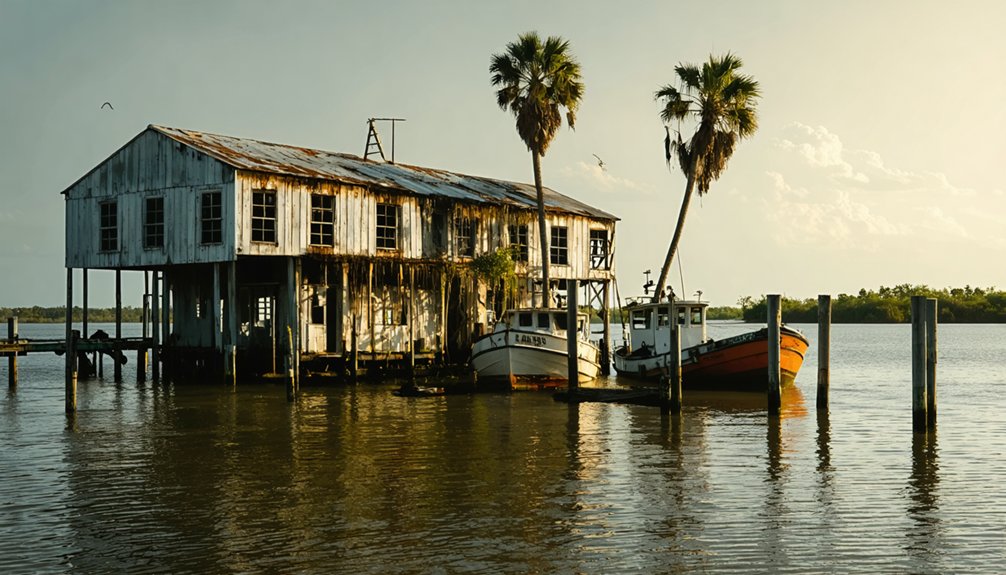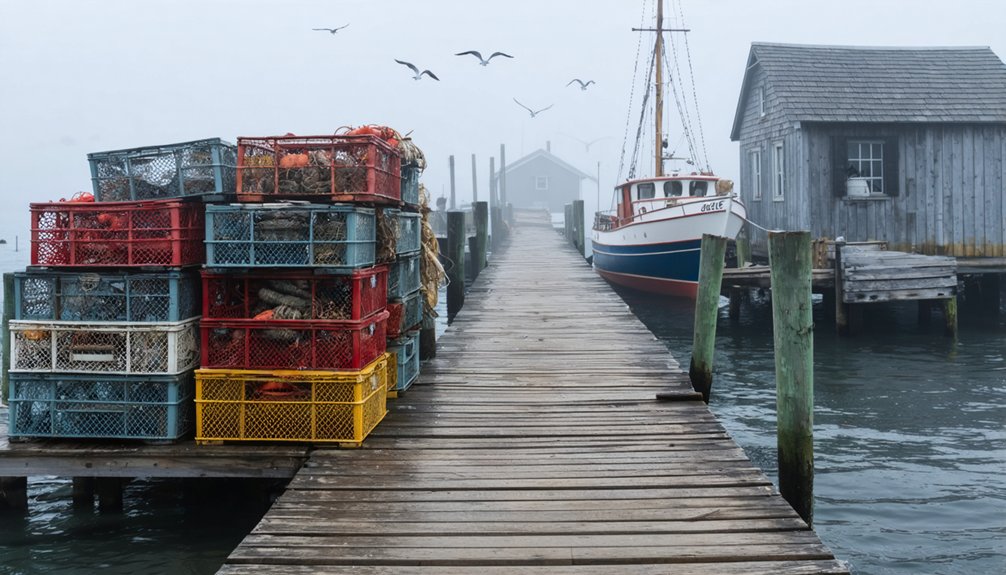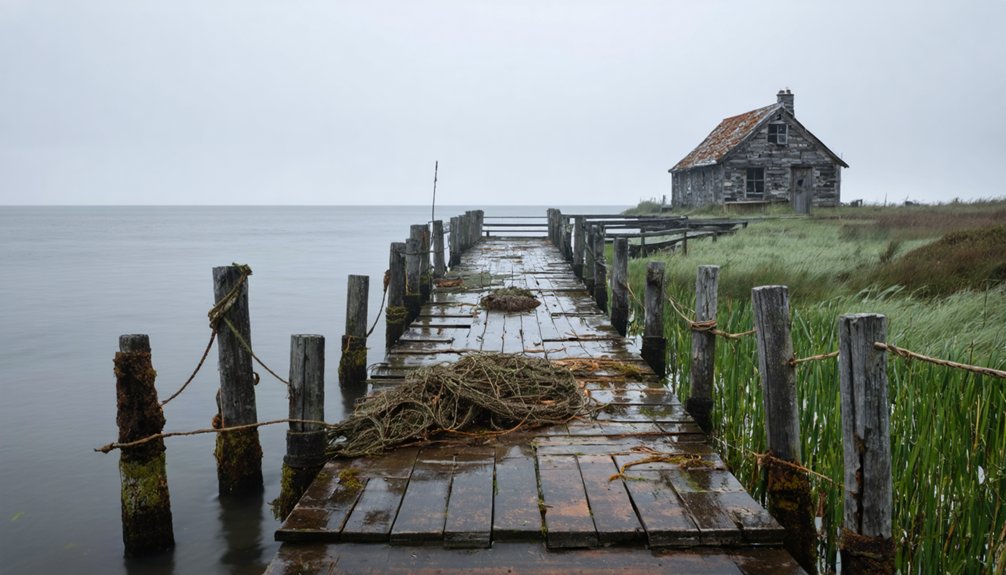America’s most hauntingly beautiful abandoned fishing villages include Terminal Island’s forcibly evacuated Japanese community, Helltown’s rugged Portuguese settlement on Cape Cod, and Point Lobos’ vanished Chinese village. You’ll discover North Carolina’s Portsmouth Village and Mashoes, Louisiana’s decaying canneries, and Florida’s resilient Cortez Village that survived while others perished. Each weathered pier and crumbling structure tells a story of maritime life, cultural heritage, and communities that rose and fell with the tides.
Key Takeaways
- Helltown on Cape Cod was a seasonal Portuguese fishing settlement known for impressive cod harvests totaling a million pounds per winter.
- Terminal Island’s Japanese-American fishing community was forcibly evicted after Pearl Harbor, leaving only a monument to commemorate their heritage.
- Point Lobos Chinese Fishing Village established Monterey Bay’s first commercial fishing industry before being destroyed by fire in 1906.
- Portsmouth Village in North Carolina was once a thriving colonial shipping center established in 1753 before being completely abandoned by 1971.
- Louisiana’s ghost canneries in Golden Meadow, Leeville, and Fala represent abandoned fishing infrastructure threatened by coastal erosion and hurricanes.
Helltown, Cape Cod: Where Fishermen’s Tales Blur With Folklore
Where the windswept shores of Cape Cod bend toward the churning Atlantic, a forgotten hamlet once thrived in winter’s harshest months. Helltown emerged near Herring Cove after 1871, a rugged seasonal settlement of Portuguese dorymen seeking proximity to rich fishing grounds.
You’ll find no census records of this transitory community, yet it pulsed with life as fishermen hauled up to 1,000 pounds of cod daily from frigid waters. Their collective catch—reaching a million pounds per winter—traveled by horse-drawn wagon to feed distant cities. The fishermen endured extreme conditions, rising before dawn to begin their treacherous daily journeys. These resilient seafarers constructed crude shelters that barely protected them from the elements.
Helltown earned its name through the fishing folklore of hard men who, after battling merciless seas, sought solace in drinking and gambling.
Terminal Island: The Forced Abandonment of a Japanese Fishing Community
You’ll find no trace of the vibrant “Furusato” fishing community that once thrived on Terminal Island, where Japanese-Americans pioneered innovative tuna fishing techniques and built a cultural haven with its own unique dialect.
After Pearl Harbor, the U.S. government forcibly evicted all 3,000 residents within 48 hours, destroyed their homes, and erased nearly all physical evidence of this maritime community’s existence.
What remains today are only whispers of a once-prosperous village where generations of skilled fishermen transformed Southern California’s seafood industry before becoming casualties of wartime hysteria and racial prejudice. The Scripps Institution of Oceanography conducted important marine biology research in this area before the community’s displacement. The community’s resilience endures through the Terminal Island Monument, which features a traditional torii gate commemorating their cultural heritage despite decades of erasure.
Wartime Racial Injustice
Terminal Island’s Japanese fishing community suffered one of America’s most egregious acts of wartime racial injustice, becoming the first victims of mass forced relocation after Pearl Harbor.
You can trace the community’s destruction through systematic racial profiling – FBI agents immediately arrested Japanese fishermen and leaders, while military personnel with bayonets patrolled streets, ransacked homes, and imposed strict curfews.
By February 1942, only women and children remained, surrounded by armed soldiers.
Despite their economic contributions and community resilience, these families received no due process when Executive Order 9066 forced their removal.
The navy demolished their once-vibrant village, erasing nearly all physical evidence of their existence.
Of 3,000 residents displaced, 60% were American citizens – their constitutional rights summarily discarded in the name of national security, leaving nothing to return to after the war.
The community maintained connections despite this displacement, eventually forming the Terminal Island Club in 1971 to preserve their shared heritage through annual gatherings.
Today, descendants of Terminal Island residents are campaigning to secure historic-cultural monument status for two surviving buildings that represent the last physical remnants of this thriving Japanese American fishing village.
Erased Maritime Heritage
Though virtually erased from America’s coastal landscape, the Japanese fishing village on Terminal Island once represented the pinnacle of maritime innovation and cultural resilience.
When you visit today, you’ll find almost nothing of this vibrant community that revolutionized tuna fishing with their bamboo pole technique. Only two buildings remain—Nanka Shoten and A. Nakamura grocery on Tuna Street—standing as lonely sentinels against complete maritime memory loss.
In 1942, following Pearl Harbor, 3,000 residents were forcibly removed overnight, their homes demolished, their livelihoods destroyed. This cultural erasure was swift and devastating. The community never recovered.
Current preservation efforts by Los Angeles and advocacy organizations focus on educating future generations about both the contributions of these innovative fishermen and the civil rights violations they endured—ensuring their story isn’t completely lost to history.
Point Lobos Chinese Fishing Village: California’s Maritime Cultural Heritage
Nestled in a sheltered cove along California’s rugged coastline, Point Lobos Chinese fishing village stands as a tribute to the pioneering spirit of immigrants who shaped America’s maritime history. Founded in 1851 by settlers from China’s Pearl River Delta, this community established Monterey Bay’s first commercial fishing industry, their cultural significance reaching far beyond their harvest.
You can almost see their distinctive fishing techniques—setting and drying squid along the shore, sharing ancestral knowledge that later contributed to marine biology. By the 1870s, the village flourished as the peninsula’s largest Chinese settlement. The area known as Cabrillo Point soon became recognized as China Point due to their prominent presence.
The villagers built their structures close to the water, creating a thriving community with Point Alones becoming the largest Chinese fishing settlement in California.
Tragically, their legacy was violently interrupted. After facing decades of prejudice and the 1882 Exclusion Act, a suspicious fire consumed the village in 1906, erasing this vibrant community from the landscape but not from history.
North Carolina’s Forgotten Fishing Villages: From Terrapin Point to Brown’s Island
Along North Carolina’s weathered coastline, forgotten fishing villages tell stories of resilience and eventual surrender to changing tides. Charles Farrell’s photographs immortalized these vanishing communities from Terrapin Point to Brown’s Island, capturing the faces and labor of those often missing from history books.
- Portsmouth Village rose as a colonial shipping center in 1753, only to be abandoned completely by 1971.
- Mashoes remained stubbornly isolated without automobile access through the 1930s, its fishermen relying on boat service.
- Mullet fishermen’s camps on Brown’s Island exemplified the harsh, independent lifestyle of coastal workers.
- Salter Path began as a squatter community, eventually winning legal recognition after generations without property deeds.
These coastal photographs now preserved at the State Archives in Raleigh provide crucial documentation of North Carolina’s maritime heritage.
When you explore these ghost villages today, you’re walking through sites where generations fought against economic tides and harsh elements before finally retreating inland. Similar to how New Hope Valley communities were displaced for Jordan Lake’s creation, these fishing villages represent cultural heritage lost to changing landscapes.
Ghost Canneries of Louisiana’s Historic Fishing Communities

Louisiana’s historic fishing communities stand as haunting monuments to a once-thriving seafood industry, with abandoned canneries dotting the bayou landscape like weathered sentinels.
You’ll discover these ghost structures in places like Golden Meadow, Leeville, and Fala, where fishing legacies once defined daily life. Built alongside marshes for easy access to fresh catches, these canneries employed generations of local families before their mid-20th century decline.
Walking through these forgotten sites, you’ll witness how coastal erosion, devastating hurricanes, and industrial consolidation transformed vibrant economic centers into silent reminders of change.
Time and nature reclaim these industrial ghosts, turning prosperity into poignant coastal memories.
The rusting machinery and crumbling walls tell stories of cannery heritage that once connected Louisiana’s coastal communities to national markets. Though many stand in disrepair, preservationists work to document these important landmarks before they disappear entirely beneath encroaching waters.
Cortez Fishing Village: Weathering Storms and Preserving Maritime Legacy
As you wander the weathered docks of Cortez, you’ll witness Florida’s oldest surviving fishing village where families have endured devastating hurricanes since 1880, including the infamous Tampa Bay hurricane of 1921 when the schoolhouse served as an essential shelter.
Historic maritime architecture surrounds you, from the 1890 Burton/Bratton Store to the 1907 Pillsbury Boat Shop, all part of the 97 structures listed on the National Register of Historic Places.
The village’s working waterfront still buzzes with activity as multi-generational fishing families bring in fresh catches daily, connecting you directly to traditional fishing methods preserved through centuries of coastal resilience.
Historical Hurricane Survival
When the furious winds of the 1921 hurricane slammed into Cortez Fishing Village with 115 mph fury, it transformed the once-thriving waterfront into a devastated landscape of splintered docks and shattered livelihoods.
Standing amid five-foot floodwaters, locals witnessed $30,000 in combined losses as stores, fish houses, and homes surrendered to nature’s wrath.
Yet Cortez’s remarkable hurricane preparedness and community resilience emerged through generations of weathering storms:
- The 1912 schoolhouse became their trusted refuge during violent tempests
- Post-hurricane fundraising saved historic structures like the Bratton Building
- Oral histories preserved through the Maritime Museum capture survival techniques
- Recent battles with Hurricanes Helene and Milton prove their enduring fortitude
You’ll feel the village’s indomitable spirit in every weathered board and restored structure—testament to a maritime community that refuses to surrender to the sea.
Fresh Seafood Legacy
The aromas of freshly caught mullet and grouper have perfumed Cortez’s salty air since 1880, when North Carolina fishing families established this maritime haven—originally called Hunter’s Point—along Florida’s Gulf Coast.
You’ll still find descendants of those original settlers pulling sustainable seafood from these waters, though Florida’s 1990s net ban forever altered their ancient rhythms. The village adapted rather than surrendered. Each February, the Commercial Fishing Festival celebrates these enduring fishing traditions, with proceeds supporting the F.I.S.H. Preserve—a 100-acre sanctuary locals once called “the kitchen.”
Despite hurricanes, red tides, and urban encroachment, Cortez remains gloriously authentic.
Visit the Florida Maritime Museum housed in the 1912 schoolhouse or simply wander among nearly 100 historic structures, where the legacy of America’s maritime past refuses to fade.
Florida Maritime Architecture
Standing in stark defiance of both time and tide, Cortez’s weathered wooden cottages tell stories that span generations.
As you wander through this resilient village, established in 1880 by North Carolinian fishing families, you’ll witness extraordinary maritime craftsmanship in buildings that have weathered devastating hurricanes since 1921.
- The 1907 Pillsbury Boat Shop, relocated multiple times yet preserved, showcases authentic boatbuilding heritage
- Simple single-story cottages with gabled roofs reflect traditional fishing community design
- The 1912 schoolhouse, now the Florida Maritime Museum, once sheltered villagers during violent storms
- Historic fish houses and working docks reveal the functional architectural preservation that defines “Old Florida”
The closely spaced waterfront homes create an atmosphere where you can almost hear the echoes of fishermen returning with their daily catch.
Comparing Abandoned Villages to Thriving Stonington: Lessons in Coastal Resilience
While abandoned coastal villages stand as reminders of failure against natural forces and economic pressures, Stonington emerges as a compelling case study in resilience.
Unlike single-industry fishing settlements that collapsed when their economic foundations eroded, Stonington’s multi-village structure created community sustainability through intentional diversification.
You’ll find stark contrasts in infrastructure development—where places like El Pardito struggled without fresh water and telecommunications, Stonington invested in essential services and transportation networks, including an AMTRAK connection linking residents to broader opportunities.
Where hurricane-ravaged Gilchrist saw permanent evacuation, Stonington’s economic diversification beyond fishing created stability.
The abandoned villages tell a haunting story of isolation and vulnerability, while Stonington demonstrates how preservation of maritime heritage can coexist with adaptability—a delicate balance that coastal communities must strike to survive nature’s wrath and economic shifts.
Frequently Asked Questions
Can Visitors Legally Explore These Abandoned Fishing Villages?
You can visit some villages legally through guided tours, museums, or public areas, but many require permits. Always check exploration regulations and prioritize visitor safety to avoid trespassing charges.
What Paranormal Activities Have Been Reported in These Villages?
You’ll encounter ghost sightings of spectral fishermen and sailors who vanished at sea. Eerie sounds of phantom boats, mysterious footsteps, and disembodied voices echo through these forgotten coastal communities after twilight falls.
Are There Underwater Remains Visible When Diving Near These Locations?
You’ll find your underwater exploration dreams hilariously shattered by murky reality, yet many sites offer stunning diving visibility near shipwrecks, docks, and fishing gear remnants—provided you dodge hurricanes and looting treasure hunters.
Which Abandoned Village Is Most Accessible for Photography Enthusiasts?
Salton Sea Beach offers you the most accessible photo opportunities. You’ll roam freely among haunting structures where vibrant graffiti meets stark scenic landscapes, all within easy reach by well-maintained highways.
How Have Climate Change and Rising Seas Affected These Historic Sites?
You’ll witness coastal erosion claiming these weathered sentinels of maritime heritage, with rising tides undermining foundations and storms battering historic structures. Historical preservation efforts race against the sea’s relentless advance.
References
- https://www.islands.com/1696596/florida-gulf-coast-hides-little-known-serene-cortez-historic-fishing-village-cortez-seafood/
- https://repository.library.noaa.gov/view/noaa/19455/noaa_19455_DS1.pdf
- https://www.youtube.com/watch?v=-Xu6l8YPQiM
- https://repository.library.noaa.gov/view/noaa/19459/noaa_19459_DS1.pdf
- https://coastalreview.org/2022/01/lost-photographs-remembering-ncs-fishing-communities/
- https://www.messynessychic.com/2021/11/23/the-japanese-fishing-village-that-vanished-from-los-angeles/
- https://www.atlasobscura.com/articles/how-chinese-fishermen-helped-build-california
- https://herlifeadventures.com/8-historic-us-coastal-towns-where-fishing-culture-still-thrives/
- https://eldredgelibrary.libcal.com/event/14678116
- https://www.lowercapenews.org/the-end-of-cape-cod



